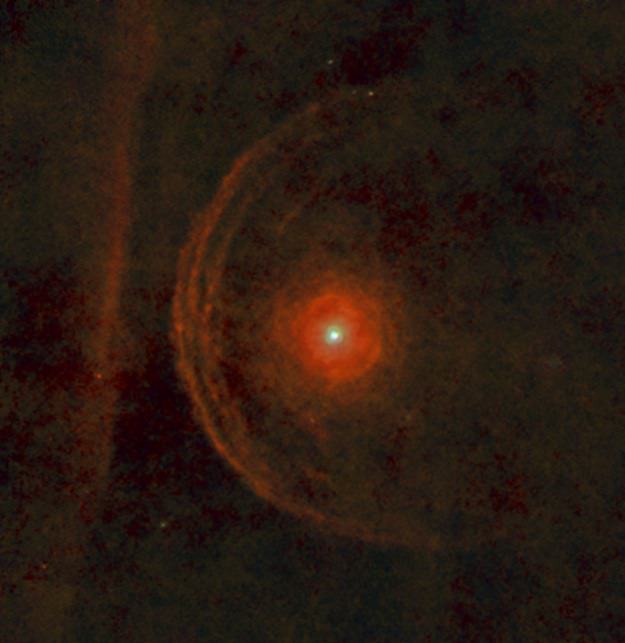A photograph of the red supergiant Betelgeuse interacting with a mysterious dusty wall. Image credit: Herschel/ESA
Betelgeuse is one of my favorite objects to look at, partly because of its pure red color, and mostly because my imagination fills in the rest. That bright red star, the shoulder of Orion is a supergiant, with dozens of times the mass of the Sun, and ready to detonate as a supernova any day now (any day within the next few million years).
But look at Betelgeuse with a really powerful telescope, like the European Space Agency’s Herschel telescope, and you’ll see something like this: the red supergiant Betelgeuse in all its glory, smashing its ferocious solar winds into its environment.
In this photograph, just released from the European Space Agency, you can see the powerful solar winds creating a bow shock around the star as it ploughs through the interstellar medium at a speed of 30 km/s. Closer into the star there are asymmetric structures, where the star shed material in fits and starts into its surroundings, like convective bubbles randomly popping to the top of a pot of boiling water.
It’s the interaction of this supergiant star and its surroundings that astronomers were attempting to unravel with their research, in a paper titled: The enigmatic nature of the circumstellar envelope and bow shock surrounding Betelgeuse as revealed by Herschel. Researchers from several European universities combined data from Herschel, the GALEX space observatory, WISE, and even radio wavelengths to study Betelgeuse and its environment. They studied the star, the bow shock, and the asymmetric clumps of material around it.
Over on the left-hand side of the photograph is a mysterious dusty wall structure that Betelgeuse is heading straight for. Because this dusty wall doesn’t curve, like the bow shock around Betelgeuse, astronomers don’t think it was caused by the star itself. According to the researchers:
The linear bar might be the edge of an interstellar cloud illuminated by Betelgeuse or a linear filament whose a possible origin is linked to the Galactic magnetic field. Since no curvature is present in the bar, we believe that the bar is not directly linked to a previous blue supergiant wind
Betelgeuse is, however, responsible for illuminating this structure, like a flashlight illuminating a nearby fog bank. And according the astronomer’s calculations, the star’s bow shock will collide with that wall in a mere 5,000 years, with the star itself following suit 12,500 years later.
Original Source: ESA News Release


I’d love to see Betelgeuse go supernova! KABANG! At ~640 light years away, no worries, fear or harm done… just a new and really cool ‘night light’? (I’d be happy if all it did was turn into a Planetary Nebula!)
Me too, but when it’s up during the day!
Me too, and some but no worries? There is the possibility of a Gamma Ray Burst and to quote from JJ Katz – The Biggest Bangs, “a few hundred light years away…. would have been several times brighter than the Sun.Radiant heat would have incinerated leaves, insects and most small land plants and animals and burned larger ones. There would have been widespread fires on half the Earth”.
Anyone know what the spin axis of Betelgeuse is? Hopefully we are not looking down the barrel.
True! The odds are vanishingly small that Betelgeuse’s polar axis is pointed directly at us.. but not zero.
If we all say it’s name three times in unison, maybe……
It appears that there’s three, possibly four concentric lines in the bow, and sweeping back.
Is it possible that the bow is previously captured dusty walls in an equilibrium between gravity and solar wind, and in the process of being wrapped around Betelgeuse?
The image is how I’d imagine a rock in a river and a row of parallel grass strands floating downstream toward it.
I’m thinking that the way the wall lines up with the bow seems too much of a coincidence not to be related.
I’ve marked my calendar 5,000 years hence for the start of the show. 😉
When Betelgeuse explodes it will shower the region with lots of material. A serious nebula will result, making it a big nebula possibly visible by the naked eye.
LC
… and poor old Orion will never hunt again… lol!
A dusty wall? Dust is dirty gas. Dirty gas is what is excluded from star making. Ask why this wall is there? On the other side of this magnetic wall holding the dirty gas out is a very big star forming. Think of it as a very big Oort shell being encountered from the outside.